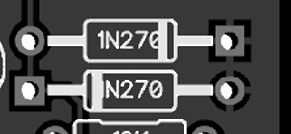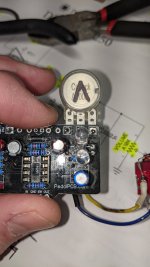cgreg714
Member
Hey all,
I'm going to build up my Distortion 250 board this afternoon, and I would like to have three clipping options:
-1N4148
-LEDs
-a yet-to-be-determined third option (possibly Schottky BAT41s?)
First time trying this, so my questions are as follow:
-is this even possible?
-is this possible with an on-off-on DPDT?
-am I correct in assuming that the LEDs would have to be put in place of both D1 and D2?
-would the DPDT center lugs be soldered to the anode of D1 and the cathode of D2?
-if three options are not a possibility, then would just the 1N4148s and the LEDs be a viable option with the DPDT?
Thanks for any and all advice.
I'm going to build up my Distortion 250 board this afternoon, and I would like to have three clipping options:
-1N4148
-LEDs
-a yet-to-be-determined third option (possibly Schottky BAT41s?)
First time trying this, so my questions are as follow:
-is this even possible?
-is this possible with an on-off-on DPDT?
-am I correct in assuming that the LEDs would have to be put in place of both D1 and D2?
-would the DPDT center lugs be soldered to the anode of D1 and the cathode of D2?
-if three options are not a possibility, then would just the 1N4148s and the LEDs be a viable option with the DPDT?
Thanks for any and all advice.





